If you were to ask writer, independent curator and antiquarian bookseller Victoria Dailey "What is the most shocking image of the late 19th century?" her answer would likely surprise you: Eugène Grasset's La Morphinomane (The Morphine Addict), which Dailey feels is "at least as shocking" as Edvard Munch's Scream series of the same era. La Morphinomane -- a desperate image of a dark-haired young woman shooting up in front of what Dailey describes as a "lurid-yellow wall" -- is one of the highlights of the not-to-be-missed exhibition "Tea and Morphine: Women in Paris, 1880-1914" at the Hammer Museum in Westwood. The exhibition closes on May 18th, so take out your calendar now...
I recently interviewed Victoria Dailey and asked her not only about the exhibition and its key images, but also about what she has learned from her involvement with the material.
John Seed in Conversation with Victoria Dailey
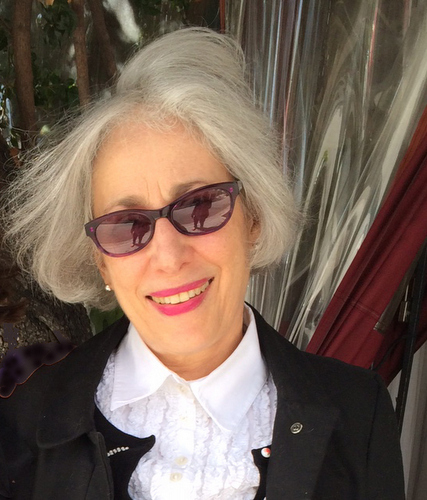
Victoria Dailey
Can you tell me how you and your co-curator Cynthia Burlingham conceived this exhibition?
I had been advising Elisabeth Dean on her collection of late-19th century French prints, and arranged for her to donate the collection to the Grunwald Center at the Hammer. To celebrate the gift, Cynthia and I decided to do a show drawn from the collection, and we knew women would be the focus of the exhibition. The Mary Cassatt etching of a woman having tea had recently been added to the collection, and I have long been fascinated with Eugène Grasset's lithograph, Morphinomane, and the idea just struck us. Tea and morphine encapsulated so much about women in Paris during what is usually called "La Belle Epoque" and we just knew that this title would yield an interesting, provocative show.

Eugene Grasset, La Morphinomane [The Morphine Addict], 1897.
Color lithograph, 22 ½ x 16 7/8 inches (57.2 x 42.9 cm).
Collection UCLA Grunwald Center for the Graphic Arts, Hammer Museum.
Promised Gift of Elisabeth Dean. Photograph by Brian Forrest.
What were some of the discoveries and revelations that you made while doing the research for "Tea and Morphine."
While I was aware that many women had difficult lives in 19th century France, I was astonished at how deeply misogyny ran throughout French culture; women in France didn't even get the right to vote until 1945! No wonder they turned to morphine, they were shut out of nearly everything (except prostitution).
Another shock is that France didn't really have a democracy until the 1870s, that despite the French Revolution, France continued with monarchy for nearly a century. After the Revolution, they had an emperor--Napoleon--then they restored the monarchy they had so violently toppled, going so far as to crown Louis XVIII and Charles X, brothers of the guillotined Louis XVI. After the Bourbon kings, they had King Louis-Philippe and another emperor, Napoleon III. By the time France had its first democratically elected president, we in the United States were on our 18th president, Ulysses S. Grant. To me, this is a staggering fact.

Henri Jean Guillaume Martin, Le silence [Silence], c. 1894 - 1897.
Color lithograph, 22 ½ x 17 inches (57.2 x 43.2 cm).
Collection UCLA Grunwald Center for the Graphic Arts, Hammer Museum.
Promised Gift of Elisabeth Dean. Photograph by Brian Forrest.
Could you mention and briefly comment on a few of your favorite works?
I mentioned Grasset's Morphinomane; it is my favorite work. It is so extreme and bold, I think of it as a companion piece to Munch's Scream. To see a young woman injecting herself with morphine in a work from 1897 is more than surprising. Another favorite is Henri Martin's depiction of a young woman as a Christ-like figure; female Christ figures are extremely rare in art, and this one is extremely haunting and mysterious.
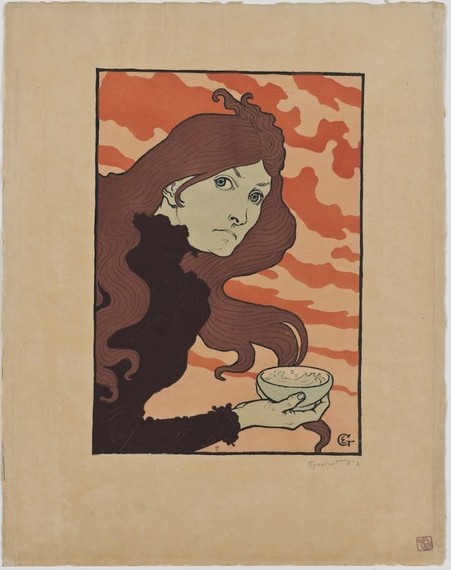
Eugène Grasset, La Vitrioleuse [The Acid Thrower], 1894.
Photo-relief with water-color stenciling, 22 7/8 x 18 inches (58.1 x 45.7 cm).
Collection UCLA Grunwald Center for the Graphic Arts, Hammer Museum.
Promised Gift of Elisabeth Dean. Photograph by Brian Forrest.
A third favorite is another work by Grasset, The Acid Thrower. An urban myth had been initiated during the Paris Commune of 1871 that involved stories of women throwing fire bombs, but no actual case ever came to light. In the 1880s, some women did throw acid onto their romantic rivals, reviving the stories about dangerous, acid and bomb-throwing women, and Grasset's image shows the angry, frustrated, green-with-envy woman about to commit her crime. This is a far cry from the usual images of the period that show Can-Can dancing, frolicking, feather-flaunting women.
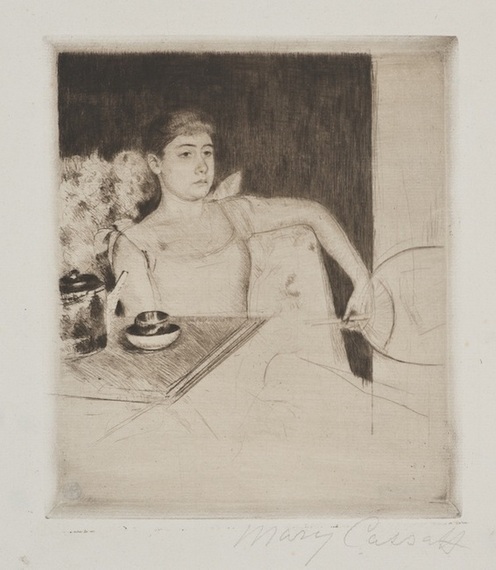
Mary Cassatt, Tea, ca. 1890, drypoint, 8 1/8 x 13 3/4 inches
Collection UCLA Grunwald Center for the Graphic Arts, Hammer Museum.
Promised Gift of Elisabeth Dean. Photograph by Brian Forrest.
In a show about women, are women artists included?
Some visitors have asked why there is only one woman artist in the show--Mary Cassatt. The answer is that there were very few women artists at the time. Along with everything else, women were shut out of higher education, including art schools, and prints by women are rare. Luckily, Mary Cassatt made etchings, and her work depicting a woman having tea is the basis for one-half of our title. Furthermore, the few women artists that did exist were mostly painters; printmaking was just not something women did at the time. It was difficult, messy, and required strength to operate heavy etching and lithograph presses; the printmaking world of the time was run by men.
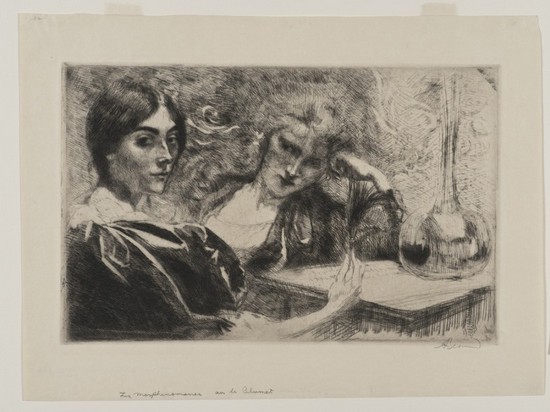
Paul Albert Besnard, Morphinomanes ou Le Plumet, 1887.
Etching, drypoint and aquatint, 12 11/16 x 17 1/4 inches (32.2 x 43.8 cm).
Collection UCLA Grunwald Center for the Graphic Arts. Purchase.
Photograph by Brian Forrest.
Is it fair to say that the subject matter found in this exhibition's prints rarely made its way into painting?
Yes, printmakers often dealt with subjects that were taboo, difficult or hidden; they weren't as public as paintings, and their frequent use as book illustrations created a literary connection that just didn't exist in paintings. Prints could depict images that explored the deeper recesses of culture that paintings often missed, and since prints were sometimes issued as a series, a range of images could illustrate one theme. In the exhibition is Albert Besnard's series La Femme, a group of twelve etchings showing the life of a woman, from marriage and childbirth to rape and suicide.

Victor Emile Prouvé, L'Opium, 1894. Color lithograph, 24 3/8 x 17 inches
Collection UCLA Grunwald Center for the Graphic Arts, Hammer Museum.
Promised Gift of Elisabeth Dean. Photograph by Brian Forrest.
Will visitors to this show find themselves looking over some of the shows more difficult themes -- including prostitution and addiction -- and feel like nothing has really changed?
Yes, visitors are astonished that drugs were so prevalent in the 19th century; drug-addiction is not a new phenomenon, but we tend to think of our ancestors as somehow naïve or innocent and that our problems are new ones. Similarly, we don't really understand how prostitution was a huge social problem over a century ago, and that it was probably worse than today since women had so few choices in life back then. In actuality, prostitution was one of very few career choices for women.
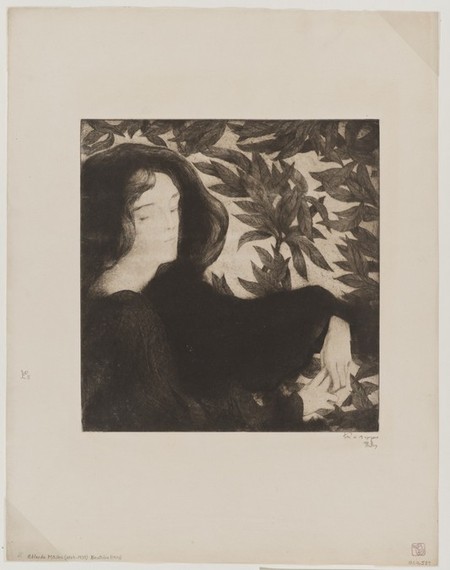
Alfredo Müller, Beatrice, c. 1899. Etching and aquatint, 25 x 19 ½ inches
Collection UCLA Grunwald Center for the Graphic Arts, Hammer Museum.
Promised Gift of Elisabeth Dean. Photograph by Brian Forrest.
Is there anything else you would like to mention about this show?
I want to give credit to Elisabeth Dean for being a fearless collector, always ready to acquire something new and interesting in order to expand and improve the collection. It has been a pleasure working with her for nearly thirty years. She has a deep understanding of French printmaking and her devotion to the subject has resulted in an extraordinary achievement. Her generosity in donating her collection to the Hammer is being recognized as one of the museum's most significant gifts.
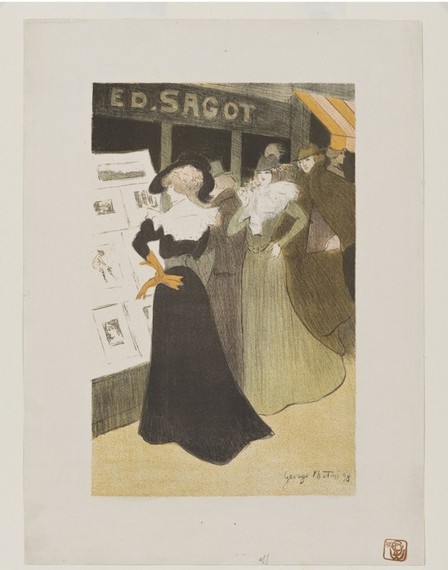
George Bottini, Sagot's Lithography Gallery, 1898.
Color lithograph, 14 7/8 x 10 7/8 inches (37.8 x 27.6 cm).
Collection UCLA Grunwald Center for the Graphic Arts, Hammer Museum.
Promised Gift of Elisabeth Dean. Photograph by Brian Forrest.
What are you working on now?
I am working on the effects of the French Revolution on women, and specifically on the role that prostitutes played in French culture, especially in the first half of the 19th century. I have discovered that as the Inuit are said to have one hundred words for snow, the French have nearly three hundred words for prostitute...from "adoratrice" to "wagon," and I am especially fond of "fleur de macadam" and "Vénus populaire." I am compiling a list that I will publish with the rest of my findings.
Tea and Morphine: Women in Paris 1880 to 1914
January 25, 2014 - May 18, 2014
The Hammer Museum at UCLA
10899 Wilshire Blvd Los Angeles, CA 90024
I recently interviewed Victoria Dailey and asked her not only about the exhibition and its key images, but also about what she has learned from her involvement with the material.
John Seed in Conversation with Victoria Dailey

I had been advising Elisabeth Dean on her collection of late-19th century French prints, and arranged for her to donate the collection to the Grunwald Center at the Hammer. To celebrate the gift, Cynthia and I decided to do a show drawn from the collection, and we knew women would be the focus of the exhibition. The Mary Cassatt etching of a woman having tea had recently been added to the collection, and I have long been fascinated with Eugène Grasset's lithograph, Morphinomane, and the idea just struck us. Tea and morphine encapsulated so much about women in Paris during what is usually called "La Belle Epoque" and we just knew that this title would yield an interesting, provocative show.

While I was aware that many women had difficult lives in 19th century France, I was astonished at how deeply misogyny ran throughout French culture; women in France didn't even get the right to vote until 1945! No wonder they turned to morphine, they were shut out of nearly everything (except prostitution).
Another shock is that France didn't really have a democracy until the 1870s, that despite the French Revolution, France continued with monarchy for nearly a century. After the Revolution, they had an emperor--Napoleon--then they restored the monarchy they had so violently toppled, going so far as to crown Louis XVIII and Charles X, brothers of the guillotined Louis XVI. After the Bourbon kings, they had King Louis-Philippe and another emperor, Napoleon III. By the time France had its first democratically elected president, we in the United States were on our 18th president, Ulysses S. Grant. To me, this is a staggering fact.

I mentioned Grasset's Morphinomane; it is my favorite work. It is so extreme and bold, I think of it as a companion piece to Munch's Scream. To see a young woman injecting herself with morphine in a work from 1897 is more than surprising. Another favorite is Henri Martin's depiction of a young woman as a Christ-like figure; female Christ figures are extremely rare in art, and this one is extremely haunting and mysterious.


Some visitors have asked why there is only one woman artist in the show--Mary Cassatt. The answer is that there were very few women artists at the time. Along with everything else, women were shut out of higher education, including art schools, and prints by women are rare. Luckily, Mary Cassatt made etchings, and her work depicting a woman having tea is the basis for one-half of our title. Furthermore, the few women artists that did exist were mostly painters; printmaking was just not something women did at the time. It was difficult, messy, and required strength to operate heavy etching and lithograph presses; the printmaking world of the time was run by men.

Yes, printmakers often dealt with subjects that were taboo, difficult or hidden; they weren't as public as paintings, and their frequent use as book illustrations created a literary connection that just didn't exist in paintings. Prints could depict images that explored the deeper recesses of culture that paintings often missed, and since prints were sometimes issued as a series, a range of images could illustrate one theme. In the exhibition is Albert Besnard's series La Femme, a group of twelve etchings showing the life of a woman, from marriage and childbirth to rape and suicide.

Yes, visitors are astonished that drugs were so prevalent in the 19th century; drug-addiction is not a new phenomenon, but we tend to think of our ancestors as somehow naïve or innocent and that our problems are new ones. Similarly, we don't really understand how prostitution was a huge social problem over a century ago, and that it was probably worse than today since women had so few choices in life back then. In actuality, prostitution was one of very few career choices for women.

I want to give credit to Elisabeth Dean for being a fearless collector, always ready to acquire something new and interesting in order to expand and improve the collection. It has been a pleasure working with her for nearly thirty years. She has a deep understanding of French printmaking and her devotion to the subject has resulted in an extraordinary achievement. Her generosity in donating her collection to the Hammer is being recognized as one of the museum's most significant gifts.

I am working on the effects of the French Revolution on women, and specifically on the role that prostitutes played in French culture, especially in the first half of the 19th century. I have discovered that as the Inuit are said to have one hundred words for snow, the French have nearly three hundred words for prostitute...from "adoratrice" to "wagon," and I am especially fond of "fleur de macadam" and "Vénus populaire." I am compiling a list that I will publish with the rest of my findings.
Tea and Morphine: Women in Paris 1880 to 1914
January 25, 2014 - May 18, 2014
The Hammer Museum at UCLA
10899 Wilshire Blvd Los Angeles, CA 90024
